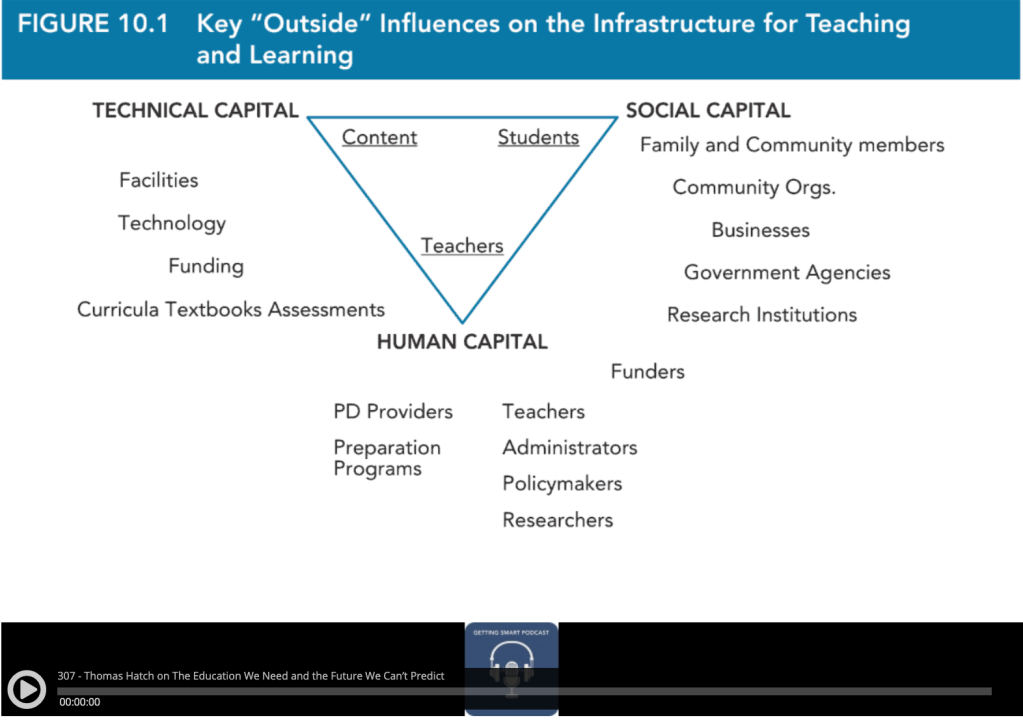In February, the Getting Smart Podcast featured a conversation with me and Tom Vander Ark about my new book The Education We Need for a Future We Can’t Predict. Tom talked with me about the key stages of my career and we walked through the key sections of the book. I was particularly interested to learn that Tom first encountered my work through my article “When Improvement Programs Collide,” published almost 20 years ago. That set us off on a discussion of how I see may work as focusing on what we need to do to improve school reform and to build the capacity of the whole eco-system of organizations, agencies, services, and people who are engaged in the work of school improvement.
What do we need to do to improve school reform efforts and build the capacity of the whole eco-system of organizations, agencies, services, and people who are engaged in the work of school improvement?
You can find the full podcast here: https://www.gettingsmart.com/2021/02/thomas-hatch-on-the-education-we-need-and-the-future-we-cant-predict/
Here are some of the key takeaways that Tom highlighted:
[:51] Thomas shares the origin story of NCREST as well as its mission.
[3:01] Tom shares his appreciation for Thomas’s early work on the concept of coherence.
[3:39] Thomas takes us to the early beginnings of his work around coherence and explains what it is and why it is important.
[7:54] Thomas tells about each of the sections in his book, starting with part 1: “Why Should Schools Change?” He headlines the case for change and provides some suggestions on how to create agreements around them.
[11:40] Tom shares the key insights he appreciated in the first section.
[12:27] The second section of the book covers barriers to change. Thomas lists some of the barriers and what we can do to make progress in overcoming them.
[15:39] In section three of Thomas’s book, he writes about how schools can improve. In particular, he focuses on high-leverage problems. Thomas explains what these are, why they’re critical, and shares some examples.
[17:33] The next section of Thomas’s book is on how education can change where he introduces the concept of micro-innovations. Thomas explains what these are and what they can do to move a system agenda forward.
[20:18] Tom shares how 4.0 Schools have been teaching this idea of micro-innovations.
[21:07] Chapter 5 of Thomas’ book is on systems change. Thomas speaks about two critical elements of systems change that are covered in this chapter: capacity building and collective responsibility.
[25:28] Would Thomas agree that it takes a decade-long push on all three of these primary levers to really promote systems change?
[27:44] Thomas reflects on his career, professional learning, and how he has seen education change over the years.
[30:29] Would Thomas say that writing is part of his learning process?
[32:00] What’s next?
Mentioned in The Episode:
- Thomas Hatch’s Website
- The Education We Need for a Future We Can’t Predict, by Thomas Hatch
- National Center for Restructuring Education, Schools, and Teaching (NCREST)
- Bill & Melinda Gates Foundation
- Project Zero
- ATLAS Communities | Project Zero
- The New American Schools Development Corporation (JSTOR)
- Success For All Foundation
- Linda Darling–Hammond
- Coalition of Essential Schools
- Theodore R. Sizer
- 4.0 Schools
- Albemarle County Public Schools
- Getting Smart Podcast Ep. 256: “Jenny Pieratt on Powerful PBL


Pingback: The Whole Child Model at the Van Ness Elementary School: A Conversation with Keptah Saint Julien (Part 1) | International Education News